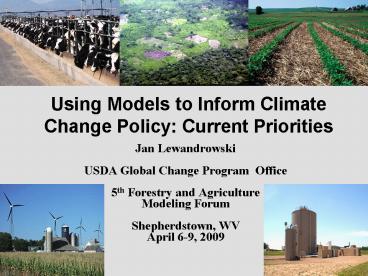Using Models to Inform Climate Change Policy: Current Priorities - PowerPoint PPT Presentation
1 / 10
Title:
Using Models to Inform Climate Change Policy: Current Priorities
Description:
Incentivizing the use of these practices and land uses is one ... What would the time path of impacts look like over 10, 25, 50, and 100 years? Thank you ... – PowerPoint PPT presentation
Number of Views:14
Avg rating:3.0/5.0
Title: Using Models to Inform Climate Change Policy: Current Priorities
1
Using Models to Inform Climate Change Policy
Current Priorities
- Jan Lewandrowski
- USDA Global Change Program Office
- 5th Forestry and Agriculture
- Modeling Forum
- Shepherdstown, WV
- April 6-9, 2009
2
Modeling Priorities
- Current conditions/baseline
- Domestic agriculture/forestry sector
- International Assessments
3
Current conditions/baseline
- Changes in specific farm/forest production and
land use management practices produce GHG
mitigation benefits - Incentivizing the use of these practices and land
uses is one straight forward approach to creating
opportunities for agriculture and forestry in a
national GHG framework. - To evaluate the potential of this approach, USDA
needs a detailed picture of current production
practices and land uses on the ground for
crops, livestock, and forestry
4
Current conditions/baseline Key Questions
- What is the difference between current practices
and 100 percent adoption? - How many farms/forests and acres would be
eligible for early adopter incentives? - Do predicted or observed changes in U.S.
practices constitute net changes? - How do practices differ among states? This would
indicate the distribution of potential benefits
and costs associated with specific
offset/set-aside provisions. - What are the current trends in carbon
sequestration in forests?
5
Domestic AF sector assessments
- It appears unlikely that agriculture and forestry
would be included as covered industries in the
context of a national GHG mitigation framework. - It is generally recognized that these sectors are
potential sources of significant low cost
mitigation opportunities. - There are very divergent views on if and how
agriculture and forestry should be included in a
national framework to reduce GHG emissions.
6
Domestic AF sector assessments Key questions
- What are the implications of including
agriculture and forestry under a set-aside, as
offsets, with both provisions? - How would agriculture and forestry be impacted by
a carbon tax on energy? - How would renewable fuel mandates affect
agriculture and forestrys GHG profile? What are
the effects of a carbon tax or cap-and-trade on
bioenergy?
7
Domestic AF sector assessments Key questions
- Can the USDA Conservation programs play a larger
role in GHG mitigation - What are the potential roles/implications of
managing public lands for GHG mitigation? - What are the implications to agriculture and
forestry of alternative choices for a baseline?
8
International Assessments
- The parties to the UNFCCC and the Kyoto Protocol
have set a goal of completing negotiations on new
agreements by December 2009. - The US has decided to include emissions from
indirect land use change in GHG lifecycle
assessments of biofuels.
9
International Assessments Key Questions
- What are the implications of international
land-use change for domestic GHG and renewable
fuels policies? - How would different global frameworks for
reducing tropical forestation affect US
agriculture and forestry markets? - How would these impacts be affected as the level
of commitment increases? - What would the time path of impacts look like
over 10, 25, 50, and 100 years?
10
- Thank you































